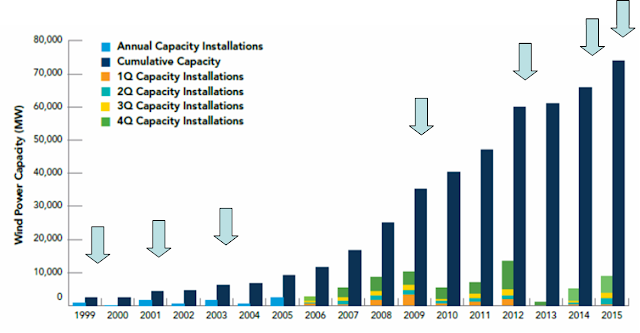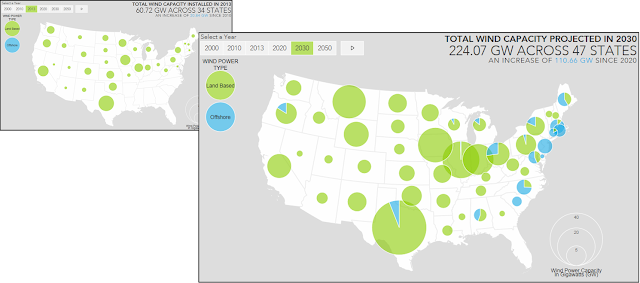Summary: The
author recently participated in a tour of Connecticut
Wind generation
capacity has grown dramatically, but erratically, in the U. S.
The Department
of Energy foresees major expansion of wind energy by 2030, and even more by
2050. Wind could provide a significant
fraction of U. S.
At present, BNE Energy’s farm consists of two wind
turbines. Planning for a third turbine
is underway. The towers to the hub that houses
the generation equipment are about 330 feet (100 m) high, and the blades are
about 135 feet (41 m) long. Each turbine,
made by General Electric, can produce 2.85 MW of electricity. The scale of this equipment is truly
inspiring, as can be seen below.
Photos: Henry Auer
The BNE Energy wind farm project took many years to
come to fruition, including a three-year battle with local opponents of the
project. They were concerned, among
other factors, about noise pollution from the rotating rotors. This aspect of the process was concluded by a
favorable decision from the Connecticut Supreme Court in 2014, allowing the
project to continue.
There was also
opposition from activists concerned about collisions between the rotors and
birds in flight. During our visit
Mr.Zupkus pointed out a person crisscrossing the meadow beneath one of the
turbines. He said this was an
environmentalist looking for dead birds.
He pointed out that from the time the wind farm began producing
electricity in October 2015 until our visit only two dead birds had been found
by such searches.
The energy from
this wind farm enters the local electricity grid via a feeder line that is only
1 ½ miles (2.4 km) long, a very short distance indeed. This helped keep the cost of the project
low. The amount of electricity is enough
to provide the power for the residents of nearby towns.
The project’s cost
is US$23 million. It benefited from a U. S. BNE Energy will be earning profits.
Developing wind
energy creates new jobs. During
construction the contractors employed several dozen high-skilled workers. Furthermore, the project promotes secondary
labor demand in the fabrication of the various parts of the wind turbine
installations such as steel working, manufacturing the turbine blades, and
electronic controls for operation.
During operation there are far fewer job needs, as the day-to-day
functioning of the turbines is largely controlled electronically. Expansion of wind energy will obviously
create many more job opportunities in the future.
Discussion
Wind Energy in the U. S. The installed wind generation capability in the U. S.
Annual and
cumulative wind-powered generation capacity.
DEEP BLUE , cumulative capacity. AQUA and MULTI-COLORED
bars, generation capacity added each year.
The arrows show dates of expiration of federal production tax credits
(see text).
Source: Adapted
from the American Wind Energy Association, http://www.awea.org/Resources/Content.aspx?ItemNumber=5059.
Production Tax Credit. It is seen that the
annual capacity additions (light-colored bars) surge to time-dependent
maxima, than fall precipitously the following year. These are indicated by the arrows in the
graphic above, and arise as follows. A
federal production tax was enacted in 1992 but allowed to expire in December
1999;
after six months it was reinstated until December 2001; after 3 months it was
reenacted until December 2003; after 10 months it was again reinstated until
2009, at which time wind businesses could choose between three taxing
alternatives until 2012 when the production tax credit again expired; it was
renewed to expire in Dec. 2014; it was again renewed for 1 year to Dec. 2015. “Congress giveth and Congress taketh
away.”
These serial enactments and
expirations of production tax credits left the wind industry whipsawed, unable
to plan effectively for new investment.
As a result, after the expiration of each short-term credit the graphic
above shows that annual installation of new generation capacity fell
dramatically. Congress finally recognized the detrimental effects of its
fits-and-starts legislative actions.
Accordingly, the production tax credit was further extended
at the end of 2015, made retroactive to the beginning of that year, and
extended for a five year period, to the end of 2019. The wind industry now has a stable investment
environment in place sufficient for advance planning for new wind energy
projects. It is anticipated that this
stable investment environment will lead to a significant expansion of installed
wind energy capacity (as well as solar) by the expiration of the current tax
credit.
The present tax credit regime, which benefits both wind energy and solar generation, is
expected to result in 37 gigawatts of new wind and solar capacity—a
56-percent increase during its 5 year
duration, promoting $73 billion in new investment, and enabling as many as 8
million more households to benefit from renewable energy at competitive prices.
The cost of producing wind-driven electricity has been falling dramatically in recent years.
The Levelized Cost of Energy (LCOE) is an
analysis of the lifetime costs involved in constructing and operating an
electricity-generating facility over the projected lifetime of the facility,
typically several decades. The LCOE for wind energy has fallen about 60% between 2009 and 2015, and is reaching a value that is competitive with fossil
fuel generating facilities. By the end
of the current tax credit at the end of 2019 the continued improvement of the LCOE
as time passes will certainly make wind generation fully competitive with fossil
fuel generation.
Wind energy is
projected to grow dramatically in the U. S. The U. S. Department of
Energy (DOE) projects that wind energy generation will expand dramatically in
future decades. As an example, the graphic below compares
actual wind energy production by state in 2013 with an expected extent of
generation in 2030.
Comparison of
actual wind energy generation state by state in the U. S. BLUE circles/sectors represent offshore
generation. The size of the circles is
scaled to the wind power capacity in gigawatts (right panel, calibrated by the
white circles at the lower right of the panel).
Source: U. S.
Department of Energy, http://energy.gov/articles/new-interactive-map-shows-big-potential-america-s-wind-energy-future
Actual generation
capacity in the U. S. U. S. U. S.
Benefits of wind
energy. DOE writes that by 2050
·
The
price of wind energy is projected to be directly competitive with conventional
energy technologies within the next decade.
·
Wind
energy could be a viable source of renewable electricity in all 50 states.
·
Wind
energy could support more than 600,000 jobs in manufacturing, installation,
maintenance and supporting services.
·
Wind
energy could save $508 billion from reduced pollutants and $280 billion in
natural gas costs.
·
Wind
energy could save 260 billion gallons of water that would have been used by the
electric power sector.
Conclusion
The manmade
increase in the greenhouse gas carbon dioxide accumulates in the atmosphere as
we burn fossil fuels because no natural processes exist that remove it on the
(geologically short) time scale needed to reduce global warming. Therefore it is necessary to end further
accumulation as fast as possible by actively migrating to a near zero-carbon
energy economy, i.e., one that does not rely on fossil fuels to produce energy.
Wind-driven generation
of electricity is growing dramatically in the U. S. It is one way of moving toward zero
emissions. In recent years development
of new wind facilities has responded directly to the presence or absence of the
federal production tax credit. Wind is
expected to expand even further in coming decades to a point at which it can
provide a large fraction of anticipated demand.
A stable federal policy supporting a production tax credit for wind (and
other renewable) sources is a significant factor in the growth of wind
generation until the industry becomes self-sufficient.
© 2016 Henry Auer



No comments:
Post a Comment